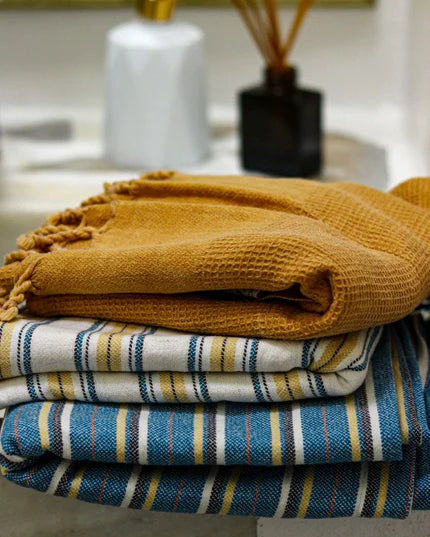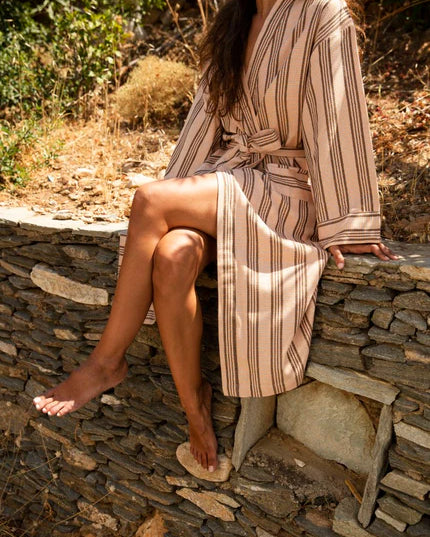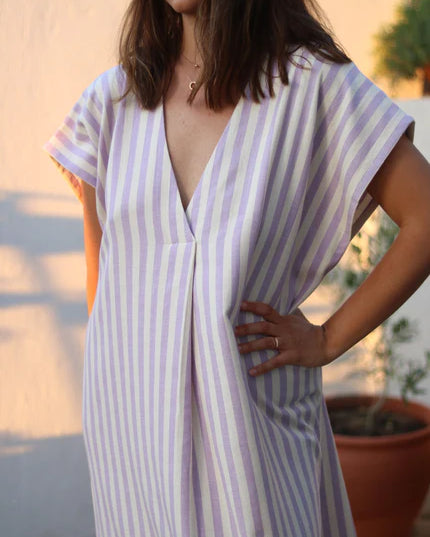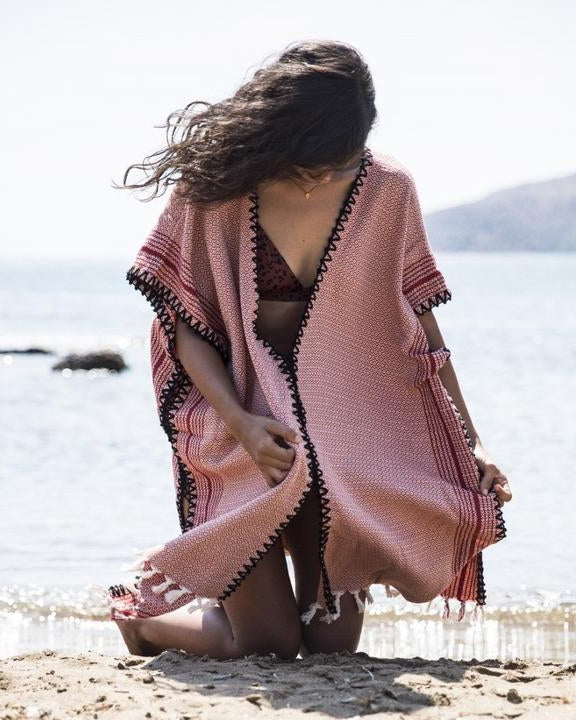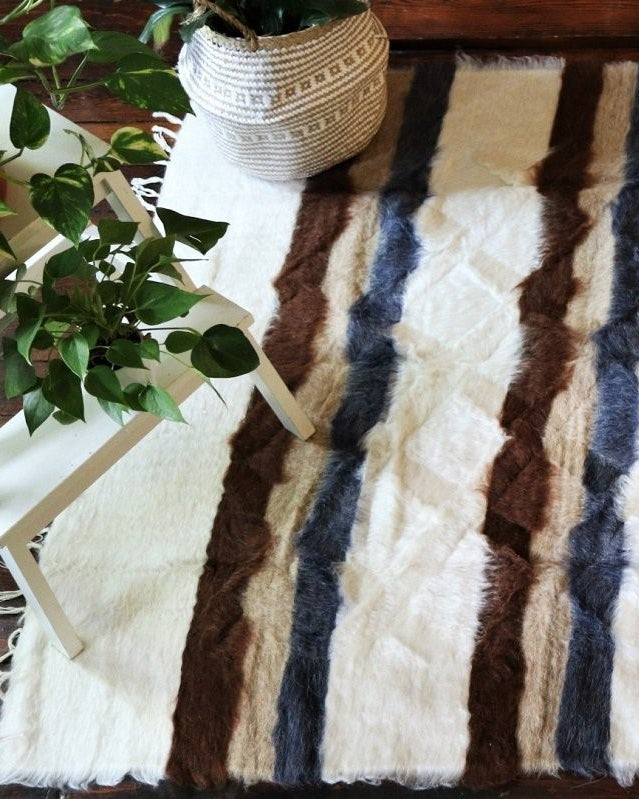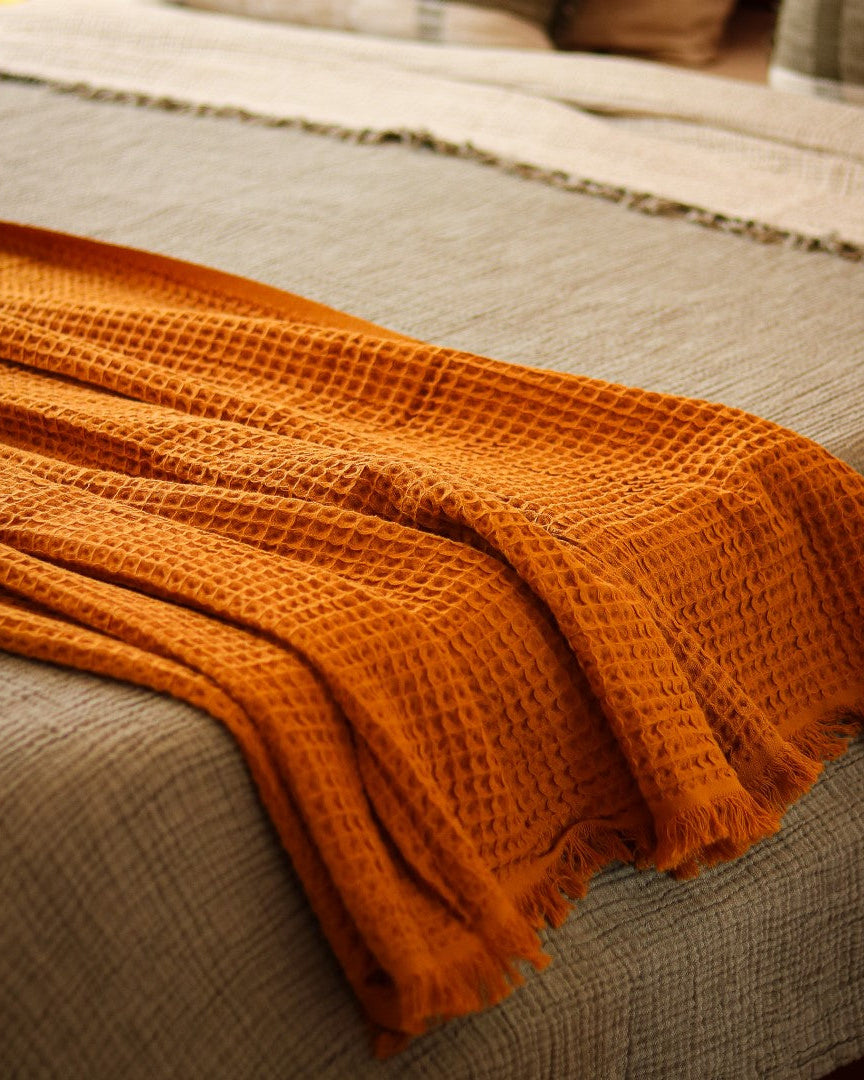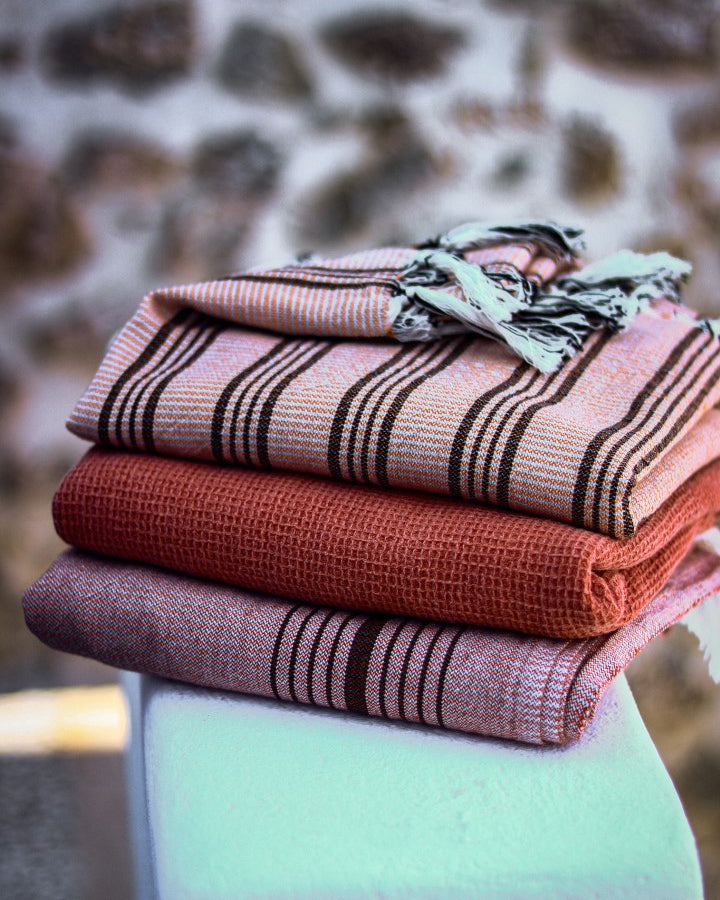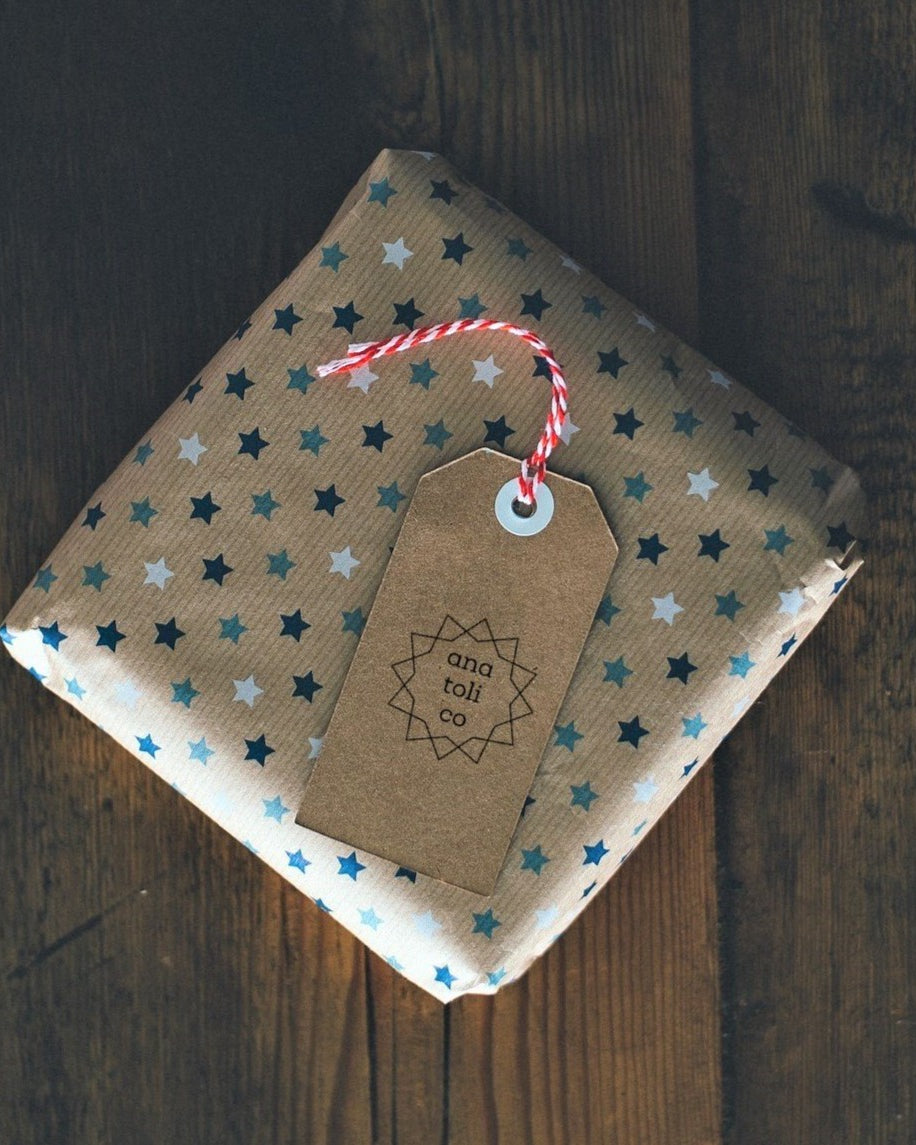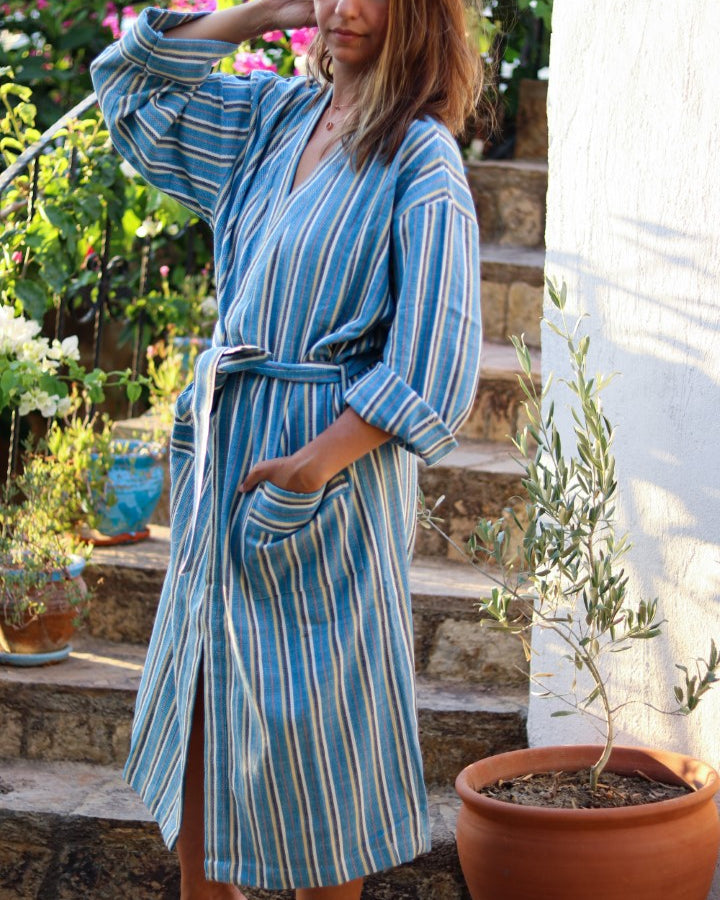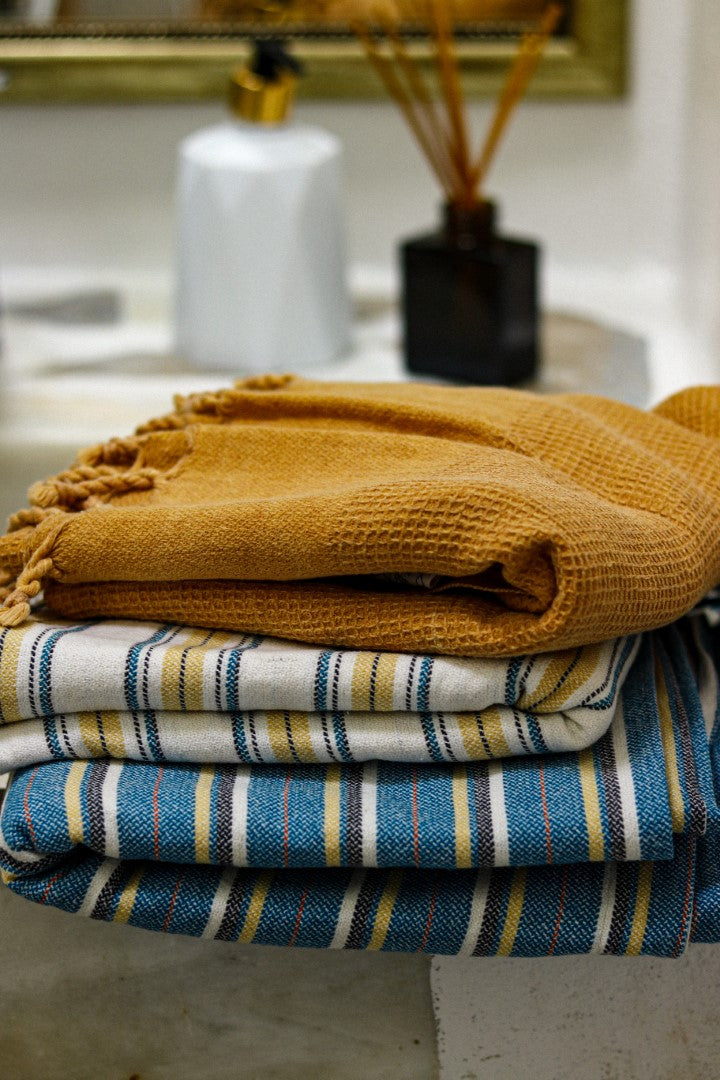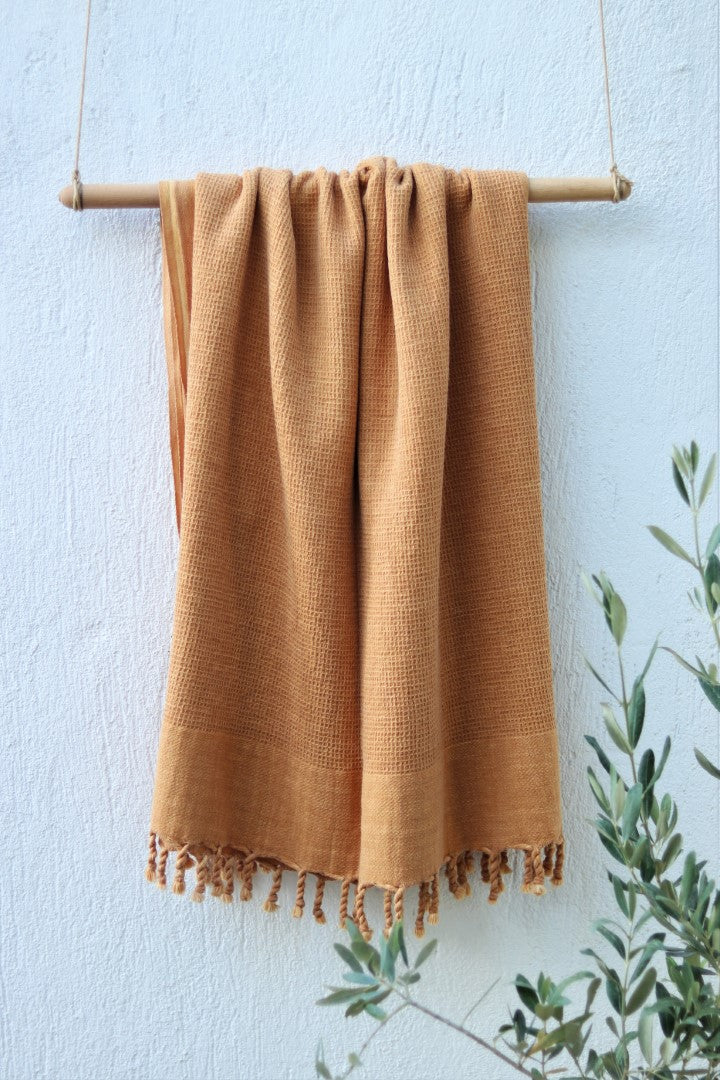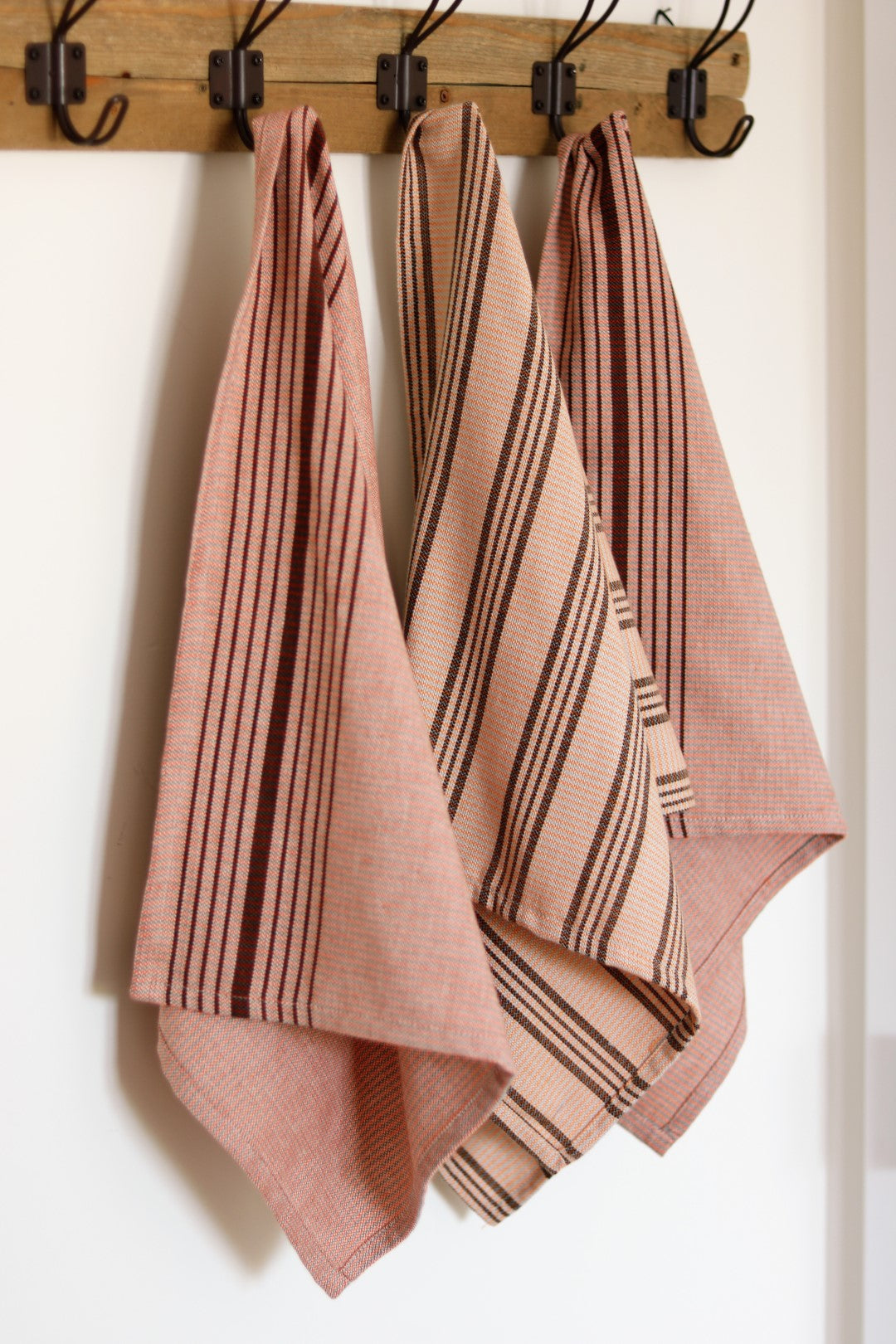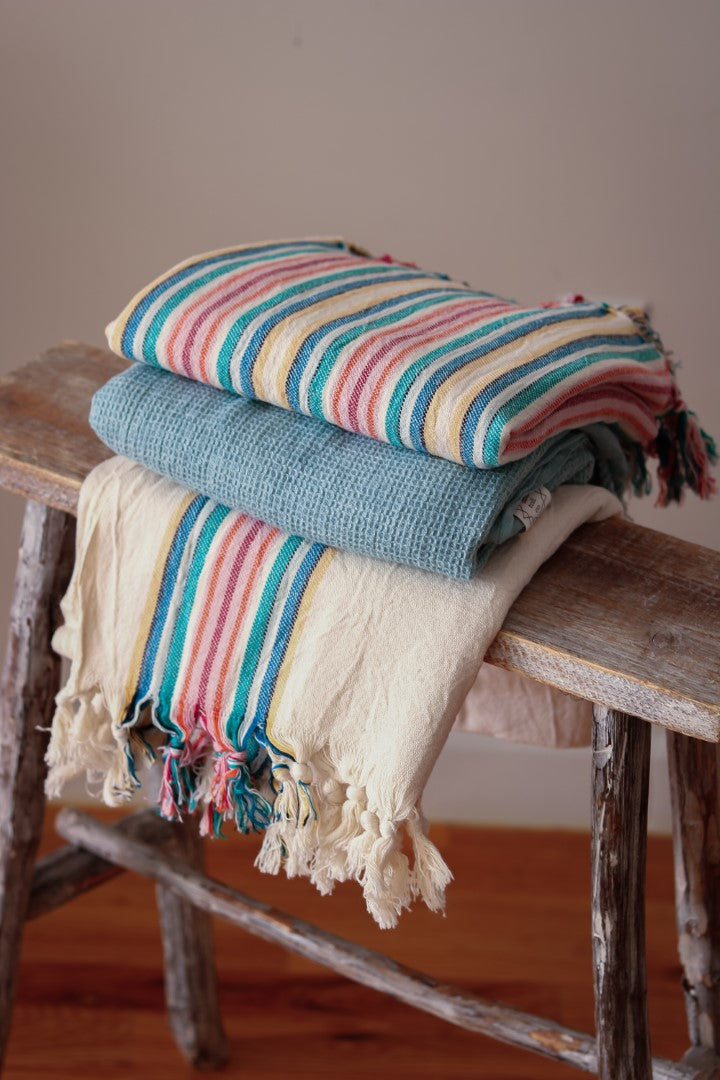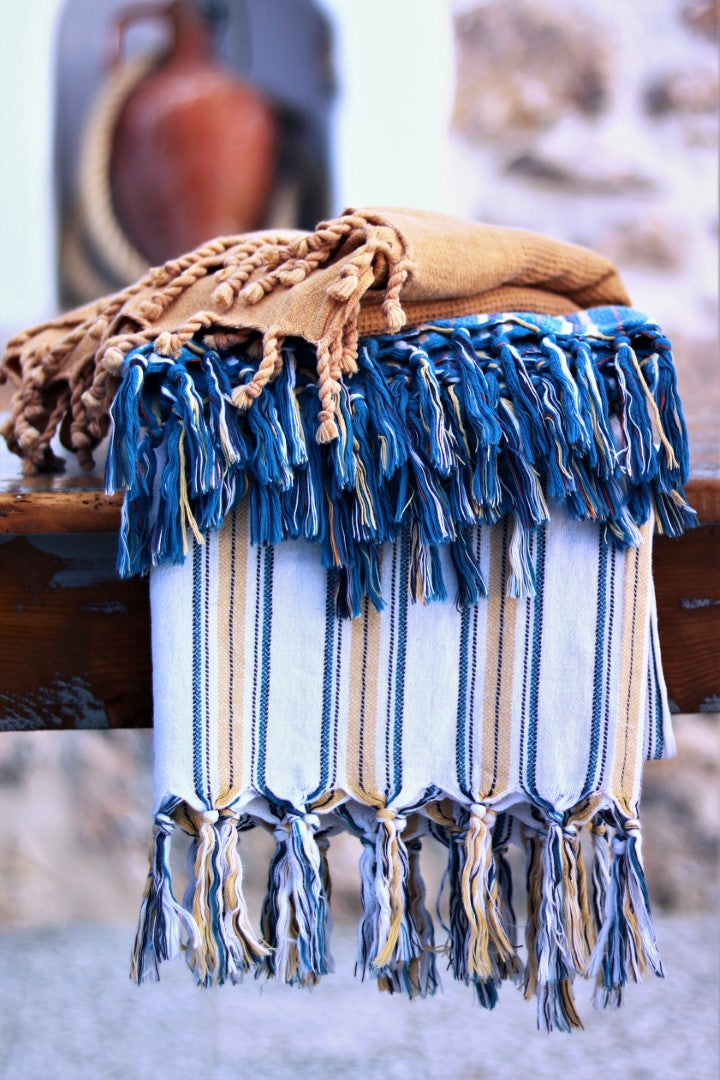Picture this: a beach towel that dries you off in moments, sheds sand with a simple flick, and then rolls up to practically nothing in your bag. That’s not a travel fantasy—it's exactly what you get with one of the best Turkish beach towels, traditionally known as a 'peshtemal'.
This unique blend of absorbency, easy portability, and effortless style is why seasoned travelers and beach lovers are making the switch.
What Makes Turkish Towels a Beach Essential
We're going to get past the hype and look at what really makes these lightweight wonders so much better than their bulky terry cloth cousins. Forget that heavy, soggy towel that seems to collect half the beach and takes forever to dry. The Turkish towel is a smarter, more elegant solution, born from centuries of craftsmanship but made for modern life.
We'll break down the core benefits, from their special construction to their incredible versatility. To really see one in action, imagine taking it on a trip to one of the world's most stunning shorelines, like the best beaches in Cyprus, where a towel like this is practically a necessity.
Unpacking the Core Advantages
The magic of a Turkish towel really comes down to a few key features that traditional towels just can't match. Once you understand these, you'll see why they're the superior choice for any day by the water.
- Hyper-Absorbent and Quick-Drying: They pull water off your skin instantly but don't get waterlogged. Thanks to their thin weave, they dry out in a fraction of the time a normal towel takes.
- Incredibly Lightweight and Compact: The flat-woven design means they fold down to a fraction of the size of a terry towel, leaving you tons of extra room in your beach bag.
- Sand-Resistant by Nature: Sand has a tough time sticking to the tight, flat weave. A quick shake is all it takes to leave the beach behind.
This isn't just a niche trend; the demand is growing worldwide. For instance, Turkey's share in U.S. imports of similar textile products is now almost 12%, and it's growing at an impressive 19% annually. This shift shows people are actively choosing the high-quality, versatile towels Turkish artisans have perfected. You can dive deeper into this trend and see the full details on Turkish towel popularity.
The Secret Behind Turkish Cotton's Magic
What makes a simple piece of fabric the best Turkish beach towel you'll ever own? It all comes down to the cotton itself. The magic starts in Turkey's Aegean Region, where a special variety of cotton grows, one that produces exceptionally long, smooth fibers.
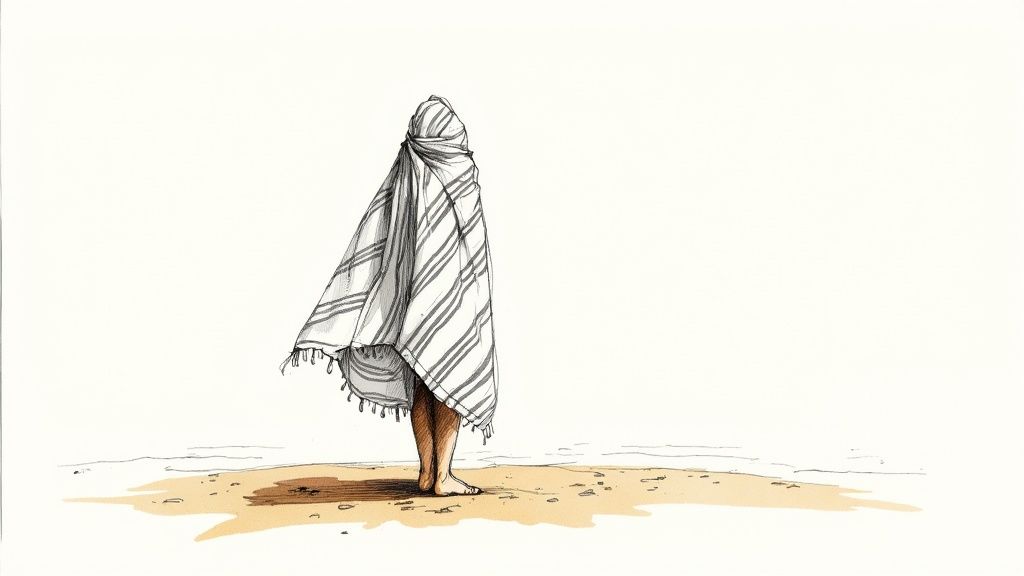
Picture regular cotton fibers as short, choppy little pieces. When you spin them into a thread, you get tons of tiny ends sticking out. This is what gives a classic terry cloth towel that thick, fluffy feel. It's cozy, sure, but it’s also what makes it bulky and take forever to dry.
Turkish cotton is a whole different ballgame. Its fibers are naturally much longer, so when they’re spun, there are fewer breaks and connection points. Think about it like making a rope from a bunch of short strings versus just a few really long ones—the long-string version is going to be way stronger, smoother, and won't fray as easily.
It's All in the Long-Staple Fibers
This "long-staple" quality is the secret ingredient. These long, elegant fibers allow weavers to create yarn that is both seriously strong and silky smooth. When that yarn is woven using traditional flat-weave techniques, you get a fabric that’s dense but also incredibly thin.
This structure completely changes how the towel deals with water. A thick terry towel is like a sponge; it soaks up water and just holds onto it. A Turkish towel, with its flat weave, wicks moisture away from your skin. The water spreads out across the thin fabric, giving it a huge surface area for the air to do its job and evaporate it quickly.
Key Takeaway: Those extra-long fibers aren't just a fun fact; they are the entire foundation of the towel's superior performance. This one botanical trait is what makes a fabric that can be absorbent, quick-drying, and durable all at the same time.
This clever design means your towel won't turn into a heavy, soggy mess after a dip. It dries out incredibly fast in the sun and breeze, which stops that dreaded musty smell from developing and makes it ready for your next swim. If you want to dive deeper into the science, you can learn more about Turkish cotton and its unique history in our guide.
From Cotton Boll to Beach-Ready Towel
The journey from the field to your beach bag involves a weaving process that has been perfected over hundreds of years. The traditional peshtemal is a flat weave, which means it has none of the little loops you see on a standard bath towel. This loop-free design is a brilliant piece of functional engineering.
Here’s a breakdown of how the fiber and the weave team up to create the perfect beach partner:
- Incredibly Absorbent: Don’t let the thinness fool you. The long, thirsty cotton fibers pull water right off your skin, getting you dry with just a few gentle pats.
- Dries in a Flash: With no thick loops to trap moisture, the entire surface of the towel is exposed to the air. This dramatically cuts down drying time—a Turkish towel can be dry in under an hour in the sun.
- Shakes Off Sand: Sand has nowhere to cling. The tight, flat weave lets sand slide right off with a good shake, keeping your car and beach bag blissfully grit-free.
- Gets Softer Over Time: Here’s the best part. These durable towels actually get softer and more absorbent with every single wash. They "break in" like a great pair of jeans, improving with age.
This unique blend of features—lightweight and portable, powerfully absorbent, and lightning-fast to dry—is a direct result of the raw material. The long fibers aren't just a perk; they're the very soul of the Turkish towel and the reason it has earned its reputation as the ultimate accessory for travel, beach days, and a touch of everyday luxury.
How to Choose an Authentic Turkish Beach Towel
Stepping into the world of Turkish towels can feel like a maze, especially with so many look-alikes on the market. But figuring out if you're holding a genuine, high-quality peshtemal is actually pretty straightforward once you know what to look for. This guide will help you spot the real deal and avoid the fakes.
Investing in one of the best Turkish beach towels is about more than just a label. It's about choosing something that will last you for years, getting softer and better with every single wash.
Start with the Material Foundation
First things first: check the material. A true Turkish towel is always made from 100% Turkish cotton. No exceptions. Don't fall for blends or vague descriptions on the tag. This specific type of cotton, known for its extra-long fibers, is the secret sauce behind the towel's famous performance.
If you see a label that says "cotton blend" or doesn't specify the origin, you're likely looking at a lower-quality imitation. It simply won't have that quick-drying, sand-shedding magic you're after. Real Turkish cotton creates a unique blend of strength and softness that other materials just can't match.
Understanding Weave and Tassels
Next up, take a close look at how the towel is made. A genuine peshtemal has a distinctive flat weave, which is precisely what makes it so incredibly lightweight and easy to pack. Run your hand across the surface—you shouldn't feel the plush, loopy pile of a typical terry cloth towel. That smooth, tight weave is crucial for shaking off sand and drying in a flash.
The tassels also have a story to tell. On many authentic, artisan-made towels, the tassels are hand-tied. Look for those small, charming imperfections; they're often a sign of a human touch, not a machine. Perfectly identical, machine-knotted tassels can be a red flag for a mass-produced product that might have cut corners on quality.
Expert Tip: A brand-new Turkish towel might feel a bit less soft than a fluffy terry towel straight off the shelf. That's actually a good thing! It means the fibers haven't been coated with chemical softeners that wash out and kill absorbency. The real, lasting softness comes naturally, building with each wash.
The Truth About Towel Weight or GSM
In the towel world, we often think higher GSM (Grams per Square Meter) means better quality—more plush, more absorbent. But for Turkish towels, you have to flip that rule on its head. The entire purpose of a peshtemal is to be light and efficient, not heavy and bulky.
A top-notch Turkish beach towel usually has a GSM between 170 and 230. This lower density is what makes it so breathable and quick-drying. If you find a "Turkish-style" towel with a very high GSM, it’s probably a terry towel hybrid, not a traditional peshtemal.
Turkish Beach Towel Feature Comparison
To make your shopping trip even easier, I've put together this quick-reference table. It compares the key features to help you choose the best Turkish beach towel for your needs, from material purity to weave style and weight.
| Feature | What to Look For | Why It Matters | Pro Tip |
|---|---|---|---|
| Material Purity | "100% Turkish Cotton" on the label. | This is your guarantee of long-staple fibers for superior absorbency, durability, and softness. | Steer clear of "cotton blends" or generic "cotton" tags—they just don't perform the same. |
| Weave Style | A flat, tight weave with no terry loops. | The flat-woven design is essential for the towel's lightweight feel and ability to repel sand. | Hold the towel up to the light; you should see a consistent, even pattern. |
| Tassel Craftsmanship | Hand-tied knots, often with slight variations. | Hand-tied tassels are a hallmark of tradition and separate authentic towels from mass-produced ones. | If the tassels look perfectly uniform, it might be a machine-made imitation. |
| Weight (GSM) | A lower GSM, typically between 170-230. | This confirms it's a true lightweight, quick-drying peshtemal, not a slow-drying terry towel. | If it feels as heavy as your bath towel at home, it’s not a real peshtemal. |
Keeping these points in your back pocket will give you the confidence to find a towel that's more than just a pretty accessory. A genuine Turkish towel is a durable, high-performing investment—a companion for countless beach days and spontaneous adventures that only gets better with age.
More Than a Towel: Versatile Everyday Uses
One of the best things about a Turkish towel is just how adaptable it is. Sure, it’s one of the best turkish beach towels you can own, but its real magic lies in all the ways you can use it off the sand. It's less of a towel and more of a multi-tool for your life.
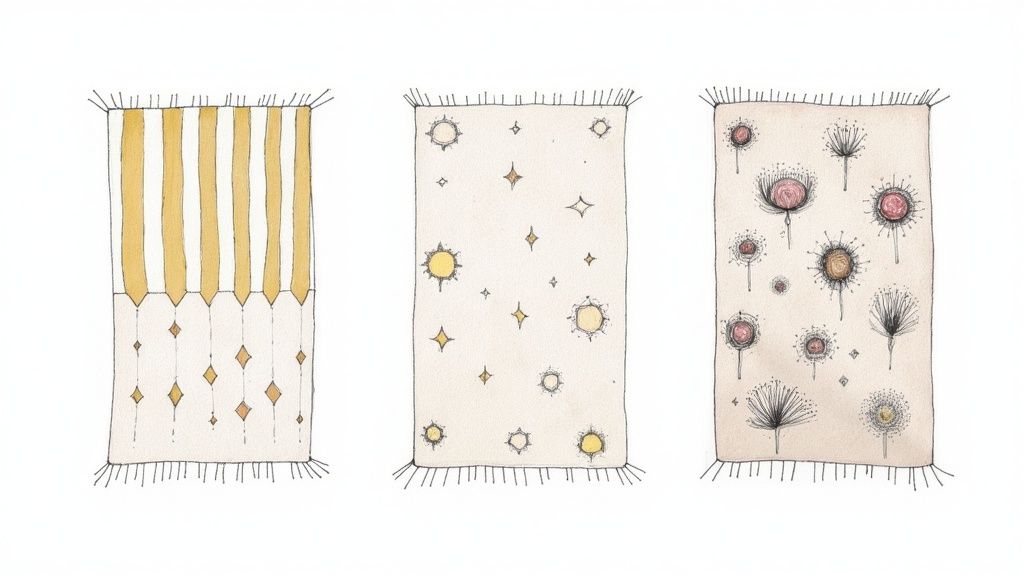
This single piece of fabric can easily stand in for a half-dozen other items, which means less clutter in your closet and more space in your travel bag. Its value is in this chameleon-like ability to become whatever you need it to be in the moment.
Your Stylish Travel Companion
If you've ever tried to travel light, you know the struggle. This is where the Turkish towel becomes a total game-changer. It’s so compact and featherlight that it’s become a must-have for minimalists and globetrotters.
-
Chic Sarong or Cover-Up: After a swim, just tie it around your waist. The beautiful patterns and colors make it a stylish pareo that looks like a deliberate fashion choice, not like you’re just wearing a bath towel.
-
Lightweight Travel Blanket: We’ve all been there—shivering on a freezing airplane or bus. A Turkish towel unfolds into a surprisingly cozy blanket, giving you just enough warmth without the weight of a traditional throw.
Because they pack down so small and dry in a flash, Turkish towels are a perfect fit for any adventurer's gear. That's why you’ll often see them recommended on an ultimate travel packing list—one item solves so many packing problems.
An Elegant Addition to Your Home
The usefulness of a peshtemal doesn’t stop when your vacation is over. Back at home, its good looks and soft feel make it a fantastic piece of decor.
-
Stylish Throw Blanket: Drape one over the arm of your sofa or at the foot of your bed. It instantly adds a relaxed, Mediterranean vibe to the room and is perfect for snuggling under on a cool night.
-
Impromptu Picnic Blanket: Thinking of a spontaneous trip to the park? Just grab your Turkish towel. It’s big enough for a comfortable spread, and since sand and dirt shake right off, cleanup is incredibly easy.
-
Versatile Table Runner: For a casual dinner party, a peshtemal can even double as a unique and rustic table runner, adding a pop of texture and color to your tablescape.
A Turkish towel is the perfect example of "less is more." It encourages a simpler way of living by showing how one high-quality, beautiful item can do the job of many, cutting down on clutter in your life.
Beyond the Beach and Home
Honestly, the possibilities are pretty much endless—it really just comes down to your imagination. People are constantly finding new and creative ways to work these amazing textiles into their daily lives.
Use it as a yoga mat towel, a lightweight gym towel that won't get musty in your bag, or even wrap it as a stylish scarf on a breezy afternoon. It's the perfect combination of durable, soft, and beautiful, making it a go-to accessory for just about any situation. For even more ideas, check out our guide to 14 ways to use a Turkish towel.
When you start to see your Turkish towel as a multi-purpose tool instead of just something to dry off with, you really unlock its full potential. It’s an investment in practicality and simple elegance that you’ll find yourself using every single day.
Preserving Softness with Proper Care
You know, a great Turkish towel is a bit like a good bottle of wine—it genuinely gets better with age. The real secret to unlocking that incredible softness and absorbency isn't some complicated cleaning ritual. It’s all about a few simple, thoughtful care steps.
Following these tips protects the long, delicate Turkish cotton fibers, making sure your towel becomes that go-to favorite you grab for years of beach trips.
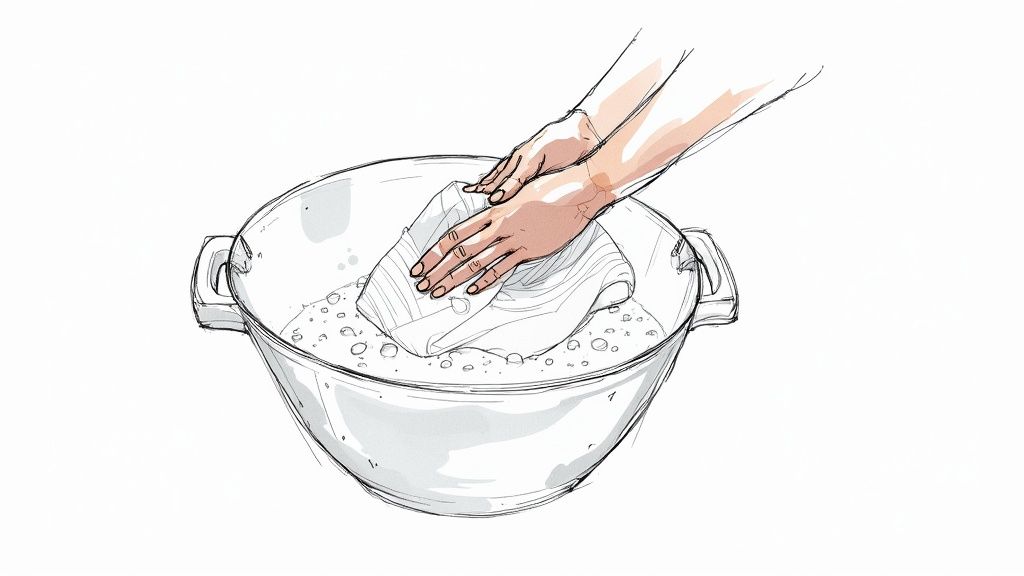
This process does more than just get it clean; it maintains the unique structure that makes these towels so amazing. Taking a few extra moments for proper care is a small investment in its long, luxurious life.
The Crucial First Step Before Use
Before you even dream of taking your new towel to the beach, it needs a good, long soak. This is, without a doubt, the most important step to “wake up” the cotton fibers and kickstart the softening process.
Think of new cotton fibers as being tightly wound and a little sleepy. Soaking them in cool water for at least 12 hours (overnight is perfect) lets them relax, expand, and start their journey toward maximum absorbency. After the soak, gently wring out the excess water and hang it up to air dry completely. This one-time ritual truly sets the stage for a lifetime of softness.
Everyday Washing Best Practices
Once your towel is part of your regular routine, laundry day is a breeze. The main goal is to be gentle. You want to protect those precious long-staple fibers that make the best Turkish beach towels so special.
Here are the golden rules for washing:
- Stick to Cool or Warm Water: Always wash your towels on a gentle cycle using cool or lukewarm water, right around 30°C (86°F). Hot water can make the cotton fibers brittle over time, which hurts both their softness and their ability to soak up water.
- Skip the Fabric Softener: I know it sounds backward, but fabric softeners are the enemy of Turkish towels. They leave behind a waxy, water-repelling film that coats the fibers, completely ruining their absorbency.
- Go Easy on Detergent: Using too much soap can leave a stiff residue. A good rule of thumb is to use about half the recommended amount of a gentle detergent. That's all you need to get it clean without the buildup.
Here's a great little trick I've used for years: add about half a cup of white vinegar to the rinse cycle every so often. It naturally strips away any lingering detergent buildup and softens the fibers without leaving any residue.
Drying Your Towel the Right Way
How you dry your towel is just as important as how you wash it. While you can use a machine, the best method is the old-fashioned one: letting it air dry.
Hanging your towel on a line is the kindest way to treat it. This preserves the integrity of the cotton and prevents any unwanted shrinkage. Plus, because they're so lightweight, they dry incredibly fast in the open air.
If you absolutely must use a machine, be sure to use a low-heat or tumble-dry setting. High heat is the fastest way to damage those delicate fibers. For a more detailed walkthrough, you can find a comprehensive guide on how to care for your Turkish towel that covers everything you need to know.
Finding Sustainable and Eco-Friendly Options
As more of us think about our environmental footprint, every choice starts to feel more significant—even the towel we pack for the beach. The great news is that the world of Turkish towels is right there with us, offering gorgeous, sustainable options that are better for the planet and your skin.
This isn't just a small trend. The global demand for beach towels is on the rise, and a huge part of that growth is a laser focus on eco-friendly products. People are actively looking for items that align with their values, which you can read more about in this report on the growing eco-friendly towel market on news.market.us.
This shift means you can now find some of the best Turkish beach towels crafted not just for their amazing performance, but for your peace of mind, too.
What Makes a Turkish Towel Eco-Friendly?
So, what exactly are you looking for when you want a truly sustainable peshtemal? It really boils down to two main things: the cotton it’s made from and the dyes that give it those beautiful colors. Get these two right, and you've found a product you can feel good about.
It all starts with certified organic cotton. This isn't just a buzzword; it means the cotton was grown without nasty pesticides or synthetic fertilizers. This approach protects the soil, uses less water, and keeps toxic chemicals away from the farmers and their communities.
Next up is the dyeing process, which is just as important. Genuinely sustainable towels use natural, plant-based dyes that come from things like roots, berries, and bark. This completely avoids the harsh chemicals and heavy metals common in conventional dyes, which can pollute our waterways and irritate sensitive skin.
Key Takeaway: Choosing an eco-friendly Turkish towel means you're getting a product free from harsh chemicals. That makes it a much gentler and safer choice for you and your family, especially if anyone has sensitive skin.
How to Identify a Genuinely Sustainable Product
Trying to make sense of product labels can feel overwhelming, but there are a couple of key certifications that act as your guide. Think of these logos as a guarantee that the towel you're buying meets strict environmental and social standards, all the way from the cotton field to the finished fabric.
Keep an eye out for these trusted certifications when you shop:
-
GOTS (Global Organic Textile Standard): This is the gold standard for anything organic. It ensures the cotton is grown organically and that the entire production process—from dyeing to finishing—is handled in an environmentally and socially responsible way.
-
OEKO-TEX STANDARD 100: This label certifies that every single part of the towel, right down to the thread and tassels, has been tested for harmful substances. If it has this label, it's completely safe for human health.
When you choose towels with these certifications, you're doing more than just buying a beautiful accessory. You're supporting a cleaner, more ethical industry and making a healthier choice for yourself. You’re not just getting a luxurious, long-lasting beach towel; you’re investing in a product that reflects a real commitment to quality, craftsmanship, and a healthier planet.
Still Have Questions? Let's Clear Things Up
Making the switch from your old, bulky towels to a sleek peshtemal can bring up a few questions. It's a completely different kind of towel, after all. Let's tackle some of the most common queries so you can feel totally confident about your choice.
Think of this as the final piece of the puzzle, answering those last few "but what about..." thoughts before you dive in.
Are Turkish Beach Towels Actually Absorbent?
Absolutely, they just work differently. A big, fluffy terry towel acts like a sponge, soaking up water and getting heavy and soggy in the process. A Turkish towel is smarter. Its long, flat-woven cotton fibers are designed to wick moisture away from your skin, drying you off quickly and efficiently.
The real magic happens after you've dried off. Because the towel itself is so thin, it dries incredibly fast. No more damp, musty smells in your beach bag, and it's ready to go for another dip much sooner than a traditional towel.
Why Does My New Towel Feel a Little Stiff?
That slight initial stiffness is actually a great sign! It means you've got a towel made from pure, natural cotton fibers, without any chemical softeners or finishes designed to create a false sense of softness on the shelf.
Here's a pro tip: Authentic Turkish towels "break in" over time, getting noticeably softer and even more absorbent with every wash. To kickstart this process, give your new towel a good soak in cool water for a few hours before its first wash. This helps the cotton fibers bloom and wake up.
How Can I Spot a Fake Turkish Towel?
The secret is in the details. First and foremost, check the tag for "100% Turkish Cotton." A genuine peshtemal feels lightweight and has a distinct flat weave—you won't see the shaggy, looped pile of a terry cloth towel.
Next, look at the tassels. On authentic towels, they are often tied by hand, so you might notice charming little imperfections. Be wary of rock-bottom prices or towels that feel unnaturally slick and soft right out of the package. That's often a sign they've been treated with chemicals that will wash out, taking the towel's absorbency with them.
Can I Put My Turkish Towel in the Dryer?
You can, but air-drying is really the way to go. It’s much gentler on the long cotton fibers and helps maintain the towel's integrity for years to come. If you're in a pinch and need to use a machine, stick to a low-heat or tumble-dry setting. High heat is the enemy—it can damage the fibers over time, making them brittle and less absorbent.
The good news? They dry so fast you'll rarely even need the dryer. Just hang it over a chair or a balcony railing, and the breeze will have it dry and ready for your next adventure in no time.
Ready to feel the difference for yourself? Check out the beautiful, artisan-crafted collection at Anatolico. You'll find the perfect towel to make your beach days better and your travel bag lighter. Discover your new favorite towel at anatolico.co.

